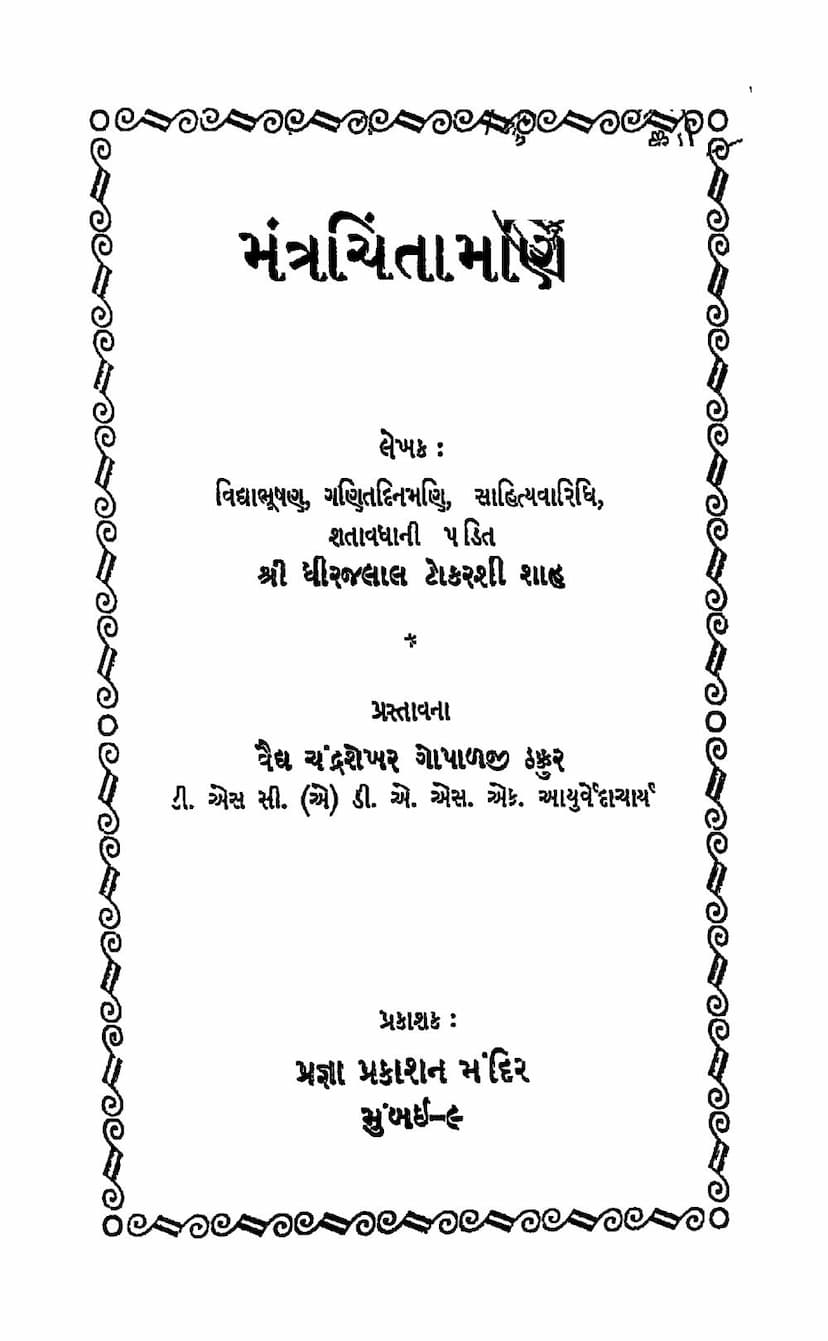Mantra Chintamani
Added to library: September 2, 2025

Summary
Here is a comprehensive summary of the Jain text "Mantra Chintamani" by Dhirajlal Tokarshi Shah, based on the provided table of contents and selected pages:
Mantra Chintamani: A Jewel of Mantra Science
"Mantra Chintamani" (The Jewel of Mantras) is a significant work in Jain literature authored by Pandit Shri Dhirajlal Tokarshi Shah, a scholar renowned for his expertise in various fields including mathematics, literature, and his remarkable feat of being a "Shatavadhani" (one who can attend to a hundred things simultaneously). Published by Pragna Prakashan Mandir, Mumbai, this book delves into the profound world of mantras, offering a comprehensive guide to their power, origin, and practice, with a particular emphasis on their relevance within the Jain tradition.
Structure and Content:
The book is divided into three main sections, each exploring different facets of mantra science:
-
Part One: Omkara and Its Worship
- This extensive section is dedicated to the primordial sound "Om" (represented as ॐ). It elaborates on the significance, origin, various names, and deeper meanings of Om.
- The text details the process of Omkāra worship, including methods of Japavidhi (chanting rituals), Dhyanavidhi (meditation techniques), Kundalini Jagaran (awakening of primal energy), and various practices known as Kalpas.
- Crucially, it highlights the specific role and practice of Omkāra worship within Jainism.
-
Part Two: Hrimkara and Its Worship
- This section focuses on another potent mantra, "Hrim" (represented as હી). It explores its various names, meanings, and the intricate methods of its worship.
- A significant portion is devoted to the specific practices of Hrimkara worship within Jainism, detailing the initial steps, completion rituals, the necessity of a mantra for worship, the consecration of the mantra, essential rules, preparatory services, daily worship procedures, and various clarifications.
- It also discusses the contemplation of the Pancha Parameshti (the five supreme beings in Jainism), the 24 Tirthankaras, and specific deities like Parshvanatha, Dharanendra, and Padmavati within the framework of Hrimkara mantra.
-
Part Three: Other Mantras and Their Applications
- This section presents a collection of various other auspicious mantras and their practical applications.
- It includes mantras for general auspiciousness, powerful mantras for overcoming ailments (like the Narayan mantra), the significance of the Panchakshari mantra, the praise of the Namaskar Mahamantra, the extraordinary power of the Gayatri mantra, and mantras for specific benefits like gaining knowledge, improving memory, finding a suitable spouse, and overcoming calamities.
Key Themes and Philosophy:
The book, through its author's diligent research and profound understanding, emphasizes several core themes:
- The Power of Mantras: "Mantra Chintamani" underscores the immense power of mantras, presenting them as potent tools for spiritual development, material prosperity, health, and protection from negative influences. The author draws parallels between mantras and divine fulfillers of desires like the Kalpavriksha (wish-fulfilling tree) or the Chintamani jewel.
- Scientific Basis of Mantras: The text argues that mantra science is not mere superstition but is rooted in ancient scientific understanding, exploring the connection between sound, energy, and consciousness. The author counters the notion that ancient Indian knowledge was primitive, highlighting the advanced scientific insights of the Rishis.
- Jain Perspective: A unique contribution of the book is its detailed explanation of how Omkara and Hrimkara are integrated and understood within the Jain philosophical and practical framework, connecting them to the core tenets of Jainism like the Pancha Parameshti and the Tirthankaras.
- Holistic Approach: The book advocates for a holistic approach to mantra practice, emphasizing the importance of ethical conduct (Achar), right intention (Bhavana), purification rituals, and disciplined practices like meditation and breath control (Pranayama) alongside mantra chanting.
- Discipline and Devotion: The author stresses that mantra siddhi requires unwavering faith, discipline, purity, and consistent effort, often guided by a qualified Guru. The book also cautions against misusing mantra power and highlights the potential pitfalls of seeking miraculous results without proper spiritual grounding.
- Overcoming Obstacles: Throughout the text, the author shares anecdotes and principles that help practitioners overcome challenges in their spiritual journey, emphasizing perseverance and the importance of righteous conduct.
Author's Background and Publisher:
The author, Pandit Shri Dhirajlal Tokarshi Shah, is presented with numerous honorific titles, reflecting his vast knowledge and contributions. The publisher, Pragna Prakashan Mandir, Mumbai, is recognized for bringing this valuable spiritual literature to the public. The book's preface is written by Vaidya Chandrashekhar Gopalji Thakkar, adding further credibility to the text.
Overall Impression:
"Mantra Chintamani" aims to demystify the science of mantras, particularly within the Jain context, making it accessible and practical for seekers. It bridges the gap between ancient wisdom and modern understanding, presenting mantras not just as religious formulas but as profound tools for transformation and well-being. The book's detailed explanations, practical guidance, and emphasis on ethical living make it a valuable resource for anyone interested in exploring the spiritual and practical dimensions of mantra chanting and worship.